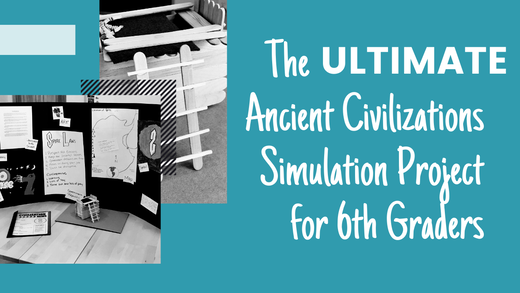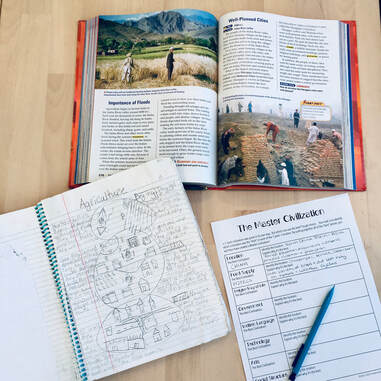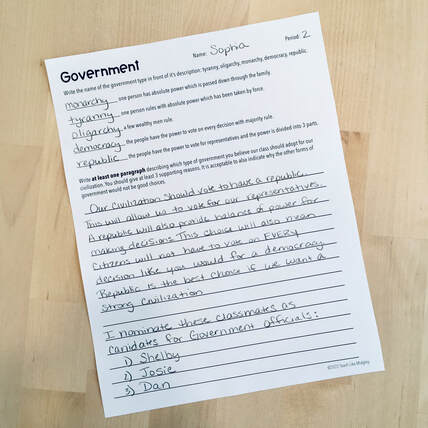The Ultimate Ancient Civilizations Simulation Project for 6th Graders
There are so many cool projects out there to help students learn. And while I’ve seen students enjoy individual or even small group projects, there’s one thing I’ve found that they enjoy even more.
And that would be whole-class simulations. I can’t even count how many students I’ve seen, years after they were in my classroom, and one thing they always remember is the whole-class simulation we do at the end of the year.
I don’t know about you, but giving kids memories like that is AMAZING.
And that would be whole-class simulations. I can’t even count how many students I’ve seen, years after they were in my classroom, and one thing they always remember is the whole-class simulation we do at the end of the year.
I don’t know about you, but giving kids memories like that is AMAZING.
Sharing this simulation project with other teacher like you, has been something on my list basically since I first started my Teachers Pay Teachers store.
But it was something that I knew would take a lot of time. And so, as I built my store with solid lessons to support teachers, I put the simulation on the back burner – so to speak.
Well, I decided that the year 2022 was the year for projects. And after waiting so long, I knew the first project I wanted to put together – finally – was the simulation project.
I planned on it taking 3 months – and I’m super pumped that I finished it in 2 ½ instead! I love beating my deadlines – it’s such a motivator for me!
So if you’re looking for something to challenge your students, leave life long memories, watch your students experience real world reality checks, and engage your students in a whole heap of fun during the end of the school year with the ULTIMATE project, then keep reading!
The Gear Up
Believe it or not, I spend a lot of time gearing up my students for this project. It’s a 5 week simulation – and it’s very engaging and hands on. Which means I need to know that my students can handle it.
The first time I mention the project is around November. I want my students to know that I’m hoping to do a project with them – but I need to know they will be ready for it.
So throughout the school year I give students challenges. Any time they are doing something that’s fairly involved with a partner – I remind them that I’m curious to see how they handle themselves.
In January, I have students complete their first small group project. And I let them know that I’ll be watching quite closely to see how they handle themselves and how they are able to work together. I’m watching to see how they treat each other and if everyone completes their assigned tasks.
This is a great management strategy – by the way – it gives students motivation to do their best throughout the year.
And by building up the project throughout the year, then by the time it actually arrives, students are SO excited that they really watch themselves because they don’t want to miss out on any of the fun.
The first time I mention the project is around November. I want my students to know that I’m hoping to do a project with them – but I need to know they will be ready for it.
So throughout the school year I give students challenges. Any time they are doing something that’s fairly involved with a partner – I remind them that I’m curious to see how they handle themselves.
In January, I have students complete their first small group project. And I let them know that I’ll be watching quite closely to see how they handle themselves and how they are able to work together. I’m watching to see how they treat each other and if everyone completes their assigned tasks.
This is a great management strategy – by the way – it gives students motivation to do their best throughout the year.
And by building up the project throughout the year, then by the time it actually arrives, students are SO excited that they really watch themselves because they don’t want to miss out on any of the fun.
Analyzing What We've Learned
Once we finish our unit on ancient Rome, it’s time to get things moving for the final project. We’ve spent all year learning about the 7 parts of various ancient civilizations. It’s time for a look back.
Not sure about the 7 parts of a civilization? Then read this blog post about How to Teach Ancient Civilizations the Easy Way.
How well can students identify the 7 parts? It’s time to find out by presenting them with a brand new civilization. This is a great time to incorporate a society that maybe you didn’t have time for, or you don’t have a lot of materials for, or maybe you just want to include for fun.
In my classroom, we cover the ancient Americas during this time. We will spend one day on each society: the Aztecs, Mayas, and the Incas. During this time, students are providing informational text, and they have to identify as much they can about the 7 parts.
This allows them to demonstrate to me that they fully understand what the 7 parts are, and what is all included with each.
Next, it’s time to analyze. Using our notebooks that we’ve filled up during the year, we look back at each society we’ve studied. And we ask ourselves an interesting question – who did it best?
Through this exercise, students think about each of the 7 parts and which society they felt was most successful – and why.
This is one of my favorite days because of the awesome discussions students have!
Through this analyzation students begin to think about what worked well and what didn’t. This really helps them to be in the right mind frame when it’s time to make their own choices.
Not sure about the 7 parts of a civilization? Then read this blog post about How to Teach Ancient Civilizations the Easy Way.
How well can students identify the 7 parts? It’s time to find out by presenting them with a brand new civilization. This is a great time to incorporate a society that maybe you didn’t have time for, or you don’t have a lot of materials for, or maybe you just want to include for fun.
In my classroom, we cover the ancient Americas during this time. We will spend one day on each society: the Aztecs, Mayas, and the Incas. During this time, students are providing informational text, and they have to identify as much they can about the 7 parts.
This allows them to demonstrate to me that they fully understand what the 7 parts are, and what is all included with each.
Next, it’s time to analyze. Using our notebooks that we’ve filled up during the year, we look back at each society we’ve studied. And we ask ourselves an interesting question – who did it best?
Through this exercise, students think about each of the 7 parts and which society they felt was most successful – and why.
This is one of my favorite days because of the awesome discussions students have!
Through this analyzation students begin to think about what worked well and what didn’t. This really helps them to be in the right mind frame when it’s time to make their own choices.
Creating A Civilization
The goal of the simulation is to create a successful civilization. Which means students are going to work together to create their 7 parts – as a whole class.
Some pieces they will discuss and decide on together. While others they will branch out and create in small groups – which actually become jobs.
At the end, they come together to learn about their civilization, along with those created by other classes. They also get the opportunity to spend their hard earned job pay.
At the core of this project, are the 4 C’s of 21st Century Learning: Creativity, Collaboration, Critical Thinking, and Communication.
Some pieces they will discuss and decide on together. While others they will branch out and create in small groups – which actually become jobs.
At the end, they come together to learn about their civilization, along with those created by other classes. They also get the opportunity to spend their hard earned job pay.
At the core of this project, are the 4 C’s of 21st Century Learning: Creativity, Collaboration, Critical Thinking, and Communication.
Whole Class Decisions
As the project begins, each student becomes a citizen of the civilization. And to start, the citizens must work together to make some decisions about their civilization.
Together, the citizens research, discuss and decide on a location for their society. The location they choose has a big impact on the resources they have available, which influence other decisions down the line.
Next comes the review of different forms of government that have been studied throughout the year. After understanding what each form of government would look like for the simulation, they discuss and decide which they would like to have.
Another whole class decision comes in the form of citizens collaborating to propose possible laws and consequences for their civilization. The teacher and Government Officials have the final say on the laws and consequences that are chosen. Their purpose is to guide citizens in making good choices and helping each other find success in performing their citizen jobs. Which also becomes a great learning opportunity to help them understand school and district rules and consequences in real life.
Together, the citizens research, discuss and decide on a location for their society. The location they choose has a big impact on the resources they have available, which influence other decisions down the line.
Next comes the review of different forms of government that have been studied throughout the year. After understanding what each form of government would look like for the simulation, they discuss and decide which they would like to have.
Another whole class decision comes in the form of citizens collaborating to propose possible laws and consequences for their civilization. The teacher and Government Officials have the final say on the laws and consequences that are chosen. Their purpose is to guide citizens in making good choices and helping each other find success in performing their citizen jobs. Which also becomes a great learning opportunity to help them understand school and district rules and consequences in real life.
Individual Accountability
The next phase of the project involves each citizen being assigned a particular job.
Over the next several days, the students work through their assigned jobs which all relate to creating their civilization. Each job produces a final product that goes on display at the end to represent their civilization.
As the teacher, I take a back seat at this point. Many of the job tasks must be approved by other citizens and the Government Officials are tasked with keeping order and making sure everyone is working.
Citizens are also earning pay for working each day, which helps to keep them motivated.
One of my favorite parts of this project is watching students develop their leadership skills. Providing support and guidance is essential – but it is also heartwarming to see the compassion, while they still hold each other accountable.
Over the next several days, the students work through their assigned jobs which all relate to creating their civilization. Each job produces a final product that goes on display at the end to represent their civilization.
As the teacher, I take a back seat at this point. Many of the job tasks must be approved by other citizens and the Government Officials are tasked with keeping order and making sure everyone is working.
Citizens are also earning pay for working each day, which helps to keep them motivated.
One of my favorite parts of this project is watching students develop their leadership skills. Providing support and guidance is essential – but it is also heartwarming to see the compassion, while they still hold each other accountable.
Putting it All Together
As the final week arrives, students have created an amazing example of collaboration and hard work. We celebrate with a Showcase Day where they get to learn about the other civilizations created by other classes through the completion of a scavenger hunt!
The next task is reviewing all that they have created, and helping them study for their final exam of the year – which is where they demonstrate their knowledge of the 7 parts they created for their civilization.
And finally, students get the opportunity to spend their hard earned job pay at Market Day!
What a fun time to let students experience what it’s like to design, create, sell, and buy goods they’ve made with their own hands! It’s also fun to invite other staff members in on market day to participate. As you can probably imagine, it looks a lot like a craft bazaar!
The next task is reviewing all that they have created, and helping them study for their final exam of the year – which is where they demonstrate their knowledge of the 7 parts they created for their civilization.
And finally, students get the opportunity to spend their hard earned job pay at Market Day!
What a fun time to let students experience what it’s like to design, create, sell, and buy goods they’ve made with their own hands! It’s also fun to invite other staff members in on market day to participate. As you can probably imagine, it looks a lot like a craft bazaar!
Ready to Roll Materials
As you can imagine, this simulation is no puny project. It’s massive, with lots of moving parts and oh, so worth the effort!
But don’t worry if it seems a bit overwhelming – it can be when you are trying to put it all together yourself – because in true Midgley fashion, I have it all put together just for you. Complete with all the details, printables, and even guidance for gathering materials and handling student behaviors.
Click the link to grab what you need and get on your way!
Create a Civilization Whole Class Simulation – Ancient World History Project
If you’re ready to have an unbelievable experience with your students – and one they won’t soon forget – then this is definitely the project you seek!
But don’t worry if it seems a bit overwhelming – it can be when you are trying to put it all together yourself – because in true Midgley fashion, I have it all put together just for you. Complete with all the details, printables, and even guidance for gathering materials and handling student behaviors.
Click the link to grab what you need and get on your way!
Create a Civilization Whole Class Simulation – Ancient World History Project
If you’re ready to have an unbelievable experience with your students – and one they won’t soon forget – then this is definitely the project you seek!
You May Also Like...

Welcome! I'm Hillary Midgley, a veteran 6th grade teacher.
I create educational materials and develop curriculum for other teachers. I specialize in teaching students how to learn through my Study Skills Curriculum. I have established fundamental classroom systems and structures for teachers to help them streamline their classroom. And my passion is teaching ancient history through engaging activities with foundations in academic skills. Here you will find resources on all of these topics and more. Learn more about me here.
|












